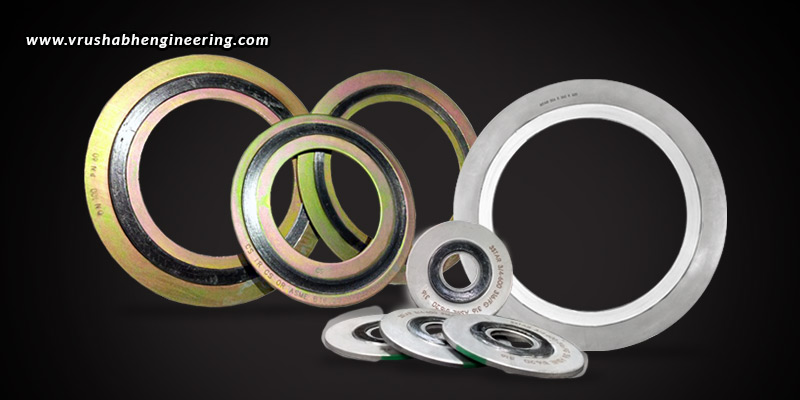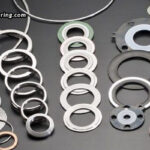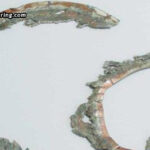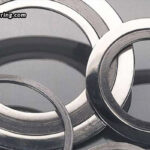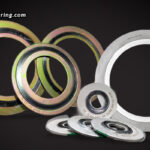The performance and reliability of sealing solutions is highly crucial in the industrial applications of today, which is why most harsh-environment industries rely on high-quality semi-metallic gaskets. High-quality here means those made from uncompromised materials, those that can offer both strength yet flexibility to be able to serve versatile industries like oil and gas, petrochemical, power generation, and marine engineering. Any compromise on the materials, or a wrong combination of the metallic and non-metallic components, can result in gasket failure, leaks, or equipment damage. This is why it is very essential to choose the right materials for your gaskets, so as to allow them to maintain effective seals under extreme pressures, temperatures, and corrosive environments.
Metallic components
The metallic component in a semi-metallic gasket is the one that provides structural strength, durability, and pressure resistance. The best materials that can used here are stainless steel, carbon steel, Inconel, Monel, and Hastelloy.
Stainless Steel
Stainless steel is the most commonly used material with grades like 304, 316, and 321 offering excellent corrosion resistance. Grade 304 is used in basic industrial applications, while Grade 316 is preferred in more aggressive chemical environments, due to its high molybdenum content that offers additional resistance to chlorides and acids. Grade 321 contains titanium, which enhances the metal’s resistance to high-temperature creep and thermal cycling, making it suitable for applications that involve repeated heat fluctuations.
Carbon Steel
Carbon steel is a more affordable option for less-demanding applications. It can provide adequate structural strength, but lacks the corrosion resistance of stainless steel or specialty alloys. The metal is used in non-corrosive fluid applications, or where gaskets are regularly replaced as part of a planned maintenance schedule.
Inconel, Monel, and Hastelloy
This category of metal are specialty nickel-based alloys that are used for environments that need extreme chemical or thermal resistance.
- Inconel is a nickel-chromium based alloy that is known for its ability to maintain strength at high temperatures, making it ideal for chemical reactors and high-temperature steam lines.
- Monel is a nickel-copper based alloy that is known for its high resistance to corrosion, making it highly suitable for chemical and marine applications.
- Hastelloys are a family of nickel-based alloys that have exceptional corrosion resistance to oxidation, as well as chemicals and acids, providing reliability in highly aggressive industrial environments.
Non-metallic fillers
The non-metallic fillers in a semi-metallic gasket ensure proper sealing by conforming to the flange surface imperfections, and accommodating thermal expansion or vibration. The most common non-metallic materials include graphite, PTFE, and Mica.
Graphite
Graphite is known for its exceptional heat resistance, chemical compatibility, and ability to conform to flange surface imperfections. Graphite performs exceptionally well at temperatures up to 450-500°C in oxidizing environments, and up to 600°C in non-oxidizing conditions. Graphite can also withstand pressures up to approximately 200 bar when properly reinforced with metallic windings. The flexibility that graphite comes with also accommodates vibration, thermal expansion, and minor flange misalignments, ensuring a reliable seal in challenging applications.
PTFE
PTFE is known for its resistance to a broad range of chemicals like strong acids and alkalis. However, it can perform well in only low-to-medium temperature applications, typically below 260°C. The material also has a low coefficient of friction and chemical inertness, which makes it suitable for sealing aggressive process fluids without the risk of contamination or chemical attacks. PTFE is thus not too good for high-temperature applications, but can work well in environments where corrosion is a primary concern.
Mica
Mica is even better than graphite in terms of temperature withstanding capabilities. They can be easily used in applications that have temperatures exceeding even 900°C! The material is chemically inert and maintains structural integrity under thermal cycling, making it ideal for usage in high-temperature furnaces, steam lines, and certain chemical processes. Mica is thus a reliable option for both temperature resistant sealing and where low leakage rates are crucial.
Key considerations when choosing materials
Now that you know the ideal materials for metallic and non-metallic components in semi-metallic gaskets, it’s equally important to consider how they perform under specific conditions; mere knowledge of their benefits isn’t enough.
Compatibility with process fluids
Different materials react differently with different chemicals, and those that are affected can result in leaks, premature failure of the gasket, equipment damage, and safety hazards. For instance, graphite fillers can work with acids, bases, and solvents, making them ideal for chemical and petrochemical applications. PTFE fillers also excel in highly aggressive chemical applications, but are limited by temperature exposure. Speaking of metals, stainless steel and specialty alloys like Monel and Hastelloy protect against corrosion in strong acids and seawater, making them apt for chemical applications too. But, materials like carbon steel simply will not work in chemical applications.
Temperature and pressure considerations
Now coming to temperature and pressure considerations, stainless steel and specialty alloys provide structural integrity at high temperatures and pressures. Non-metallic fillers like graphite can also handle extreme temperatures and pressures. On the other hand, PTFE cannot handle high-temperature or high-pressure applications, but is great for chemical applications. Then, Mica is also great for high-temperature applications, but it is very brittle and not ideal for high-pressure sealing applications due to its low compressive strength.
Best practices for gasket material selection
With so much confusion around the temperature, pressure, and chemical withstanding capabilities, let us sum up with a few best practices to help you select the right materials for your application.
- When you are looking for high temperature and high pressure applications and those that also involve chemical exposure, the best materials include stainless steel, Inconel, Monel, Hastelloy, and graphite.
- Mica is also a great option for high temperature and chemical applications, but it cannot work in high pressure applications.
- Carbon steel is an excellent choice for high pressure applications, but is not a great option for high temperatures or chemical-involving applications.
- PTFE has excellent chemical resistance, but is not a great choice for high temperature and high pressure applications.
Even though you are well acknowledged with the above summary, there are yet other best practices you can work on for the best results.
- You must assess the operating temperature and pressure ranges of your application to ensure that both the metallic and non-metallic components you choose for your gasket can withstand the conditions.
- You must consider the chemical compatibility of the materials with process fluids to prevent corrosion, degradation, or reactions that may compromise your seal.
- You must evaluate flange surface finish and load distribution to select fillers that can conform adequately without over-compression.
- You must choose appropriate support rings and metallic reinforcements to enhance structural integrity, especially in high-pressure, vacuum, or cyclic loading environments.
Throughout the above discussion, it is clear that selecting the materials for your gasket can be confusing and also a challenging affair. But, because material selection is vital for achieving performance, safety, and reliability, you certainly need to make the right choice. If you aren’t sure about your own decision, expert guidance can prove to be helpful. Vrushabh Engineering can help here with customized precision-engineered semi-metallic gaskets crafted from carefully selected materials, ensuring superior durability, sealing integrity, and long-lasting performance across demanding industrial environments.

